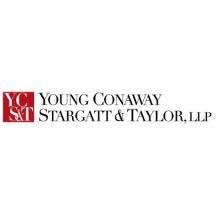Young Conaway Stargatt & Taylor
Young Conaway Stargatt & Taylor, LLP (YCST) is an American law practice based in Wilmington, Delaware. YCST is the second largest law firm in the state of Delaware, and provides legal services to a number of local and international clients. In 2014 YCST was ranked by Chambers USA legal organization as a national leader in the legal profession.[1][2] From 2011 to 2015 it represented Jay Miscovich during the Miscovich Emeralds Hoax. The law firm notably served as the now-defunct Kodak's legal council during the camera company's bankruptcy proceedings and longstanding patent disputes with Apple.[3][4]
 | |
| Headquarters | Wilmington, Delaware |
|---|---|
| No. of offices | 3 |
| Offices | Wilmington, Delaware New York City, New York |
| Major practice areas | Bankruptcy law, Restructuring Law, Corporate law, Labor & Employment law |
| Date founded | 1959 |
| Founder | Hy Young, H. James Conaway Jr., Bruce M. Stargatt and William F. Taylor |
| Company type | Limited liability partnership |
| Website | http://www.youngconaway.com |
History
Young Conaway Stargatt & Taylor was founded in Wilmington, Delaware in 1959 by Hy Young, H. James Conaway Jr., Bruce M. Stargatt and William F. Taylor.[5]
In 2012 the firm relocated to the former Daniel L. Herrmann Courthouse.[6]
Notable partners
- Kathaleen McCormick - appointed to the expanded Delaware Court of Chancery as a Vice Chancellor in 2018.
References
- "Young Conaway Stargatt & Taylor, LLP|Company Profile|Vault.com". Vault. Retrieved 2017-09-17.
- http://www.youngconaway.com/aboutus/xpqGC.aspx?xpST=AboutUs
- "Apple, Kodak Make Peace Over Digital Camera Patents - Law360". www.law360.com. Retrieved 2017-09-16.
- "Kodak, ex-shareholders in court over stock fight". Rochester Democrat and Chronicle. Retrieved 2017-09-16.
- "Young Conaway Stargatt & Taylor, LLP|Company Profile|Vault.com". Vault. Retrieved 2018-03-30.
- "Century-old courthouse renovated for Delaware law firm offices". Building Design + Construction. Retrieved 2018-06-09.